Vera and Donald Blinken Open Society Archives
Toward a Nuclear Archive: from Peaceful Atom to the Long Shadow of Chernobyl
On April 26, 1986, 37 years ago, an accident at the Chernobyl nuclear power plant caused a radioactive cloud that spread over a large area in Europe, with the western parts of the Soviet Union—today’s Belarus, Ukraine, and Russia—receiving the strongest portion of it. More than eight million people were exposed to radiation leading to death, diseases, and despair. Thirty years after the tragedy, in 2016, the UN adopted a resolution designating April 26 as International Chernobyl Disaster Remembrance Day, honoring the memory of those who perished and raising awareness about affected communities.
Currently, four nuclear power plants operate in Ukraine. At the Chernobyl Power Station, the nuclear reactors have all ceased generation by now, yet the site still requires constant management. Today, the Chernobyl nuclear plant and its confined reactor cause international concern in relation to the ongoing war that Russia launched against Ukraine. Military action keeps taking place nearby the site of the former nuclear catastrophe; after Russian troops occupied the plant in March 2022, the IAEA, deeply alarmed, has sent inspectors to Chernobyl and the four active nuclear plants in Ukraine.
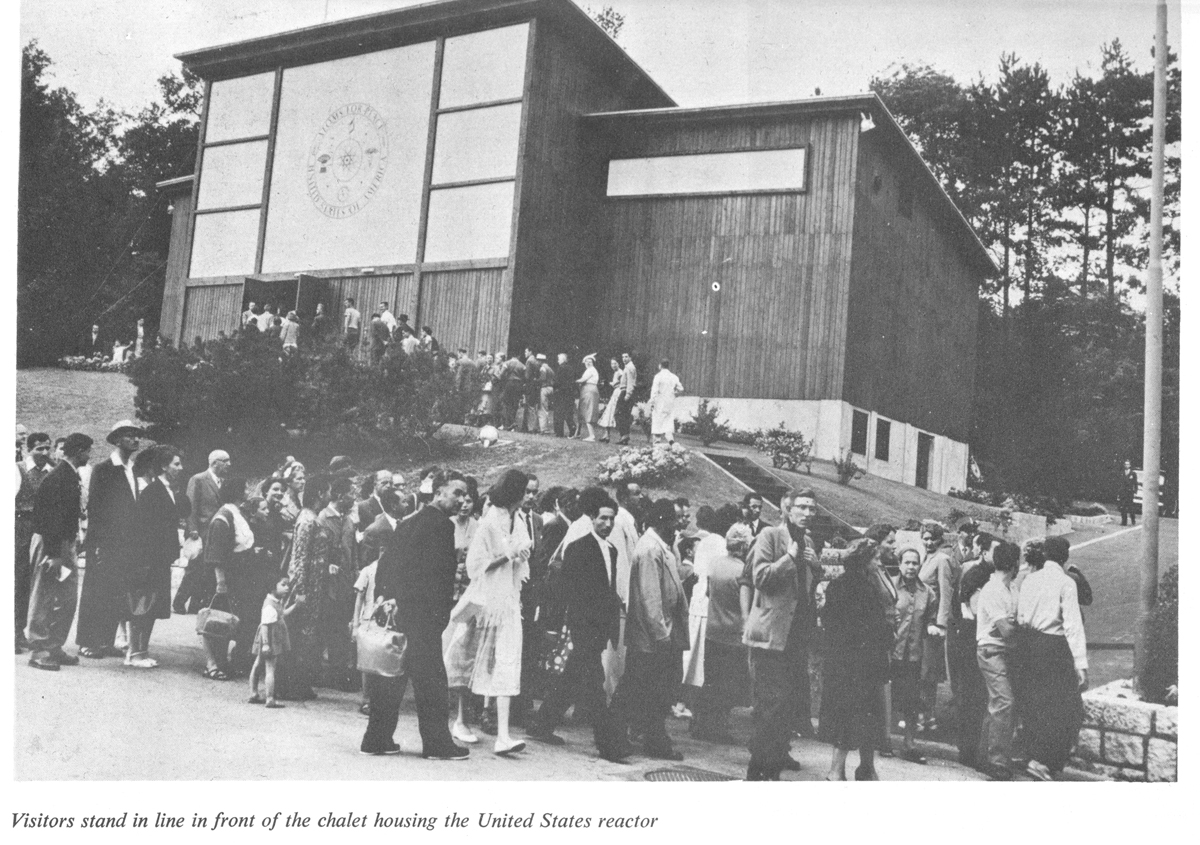 Photo from Laura Fermi’s Atoms for the World, featuring the Atoms for Peace logo.
Photo from Laura Fermi’s Atoms for the World, featuring the Atoms for Peace logo.
(Blinken OSA Archivum, Library)
Nuclear energy and its use have been subject to continuous and close attention for decades. During the Cold War, policies and debates about nuclear technology and its development, especially in weapons, excited the hearts and minds of people on both sides of the Iron Curtain, and varied from rapid proliferation to reluctant disarmament. In this post, we will overview four decades of public discourse revolved around nuclear energy and its uses in East-Central Europe, as seen through the transnational prism of what we may call a “nuclear archive.” To highlight relevant records from its holdings, the Blinken OSA Archivum compiled a thematic guide on Nuclear Energy and Its Application in 2006 (on occasion of our ATOM exhibition). Thousands of newspaper clippings, transcripts of radio programs, information items, and background analyses—primarily from the Records of Radio Free Europe/Radio Liberty Research Institute—as well as documentary films and oral history interviews, shed light on the fears and hopes of nuclear research, on preventive measures against radiation, designing and building shelters and bunkers, or raising mass awareness about what a “nuclear winter” might look like. The records illustrate that concern about atomic matters went far beyond strictly confined political, military, and scientific circles and decision makers, becoming instead a social issue that equally mattered for activists and the “silent majority.”
Information Items, covering political, economic, social, and cultural issues behind the Iron Curtain throughout the 1950s, were compiled at the RFE/RL headquarters in Munich. Based on anonymous interviews the radio’s field offices conducted with émigrés, people traveling to the West as tourists or on business, as well as defectors, Information Items were aimed at reconstructing what was happening in the Soviet Bloc. More than a hundred documents reveal the surprisingly large scale of Uranium mining in the region, including in Czechoslovakia and Poland, as well as the direct involvement of the Soviet Union (and its troops). Other topics of close attention included nuclear research and its rapid development in Hungary and Bulgaria. Specialists in Munich gathered information about professional exchanges between physicists in the region, emphasizing the unequal distribution of influence and expertise in these “scientific missions.”
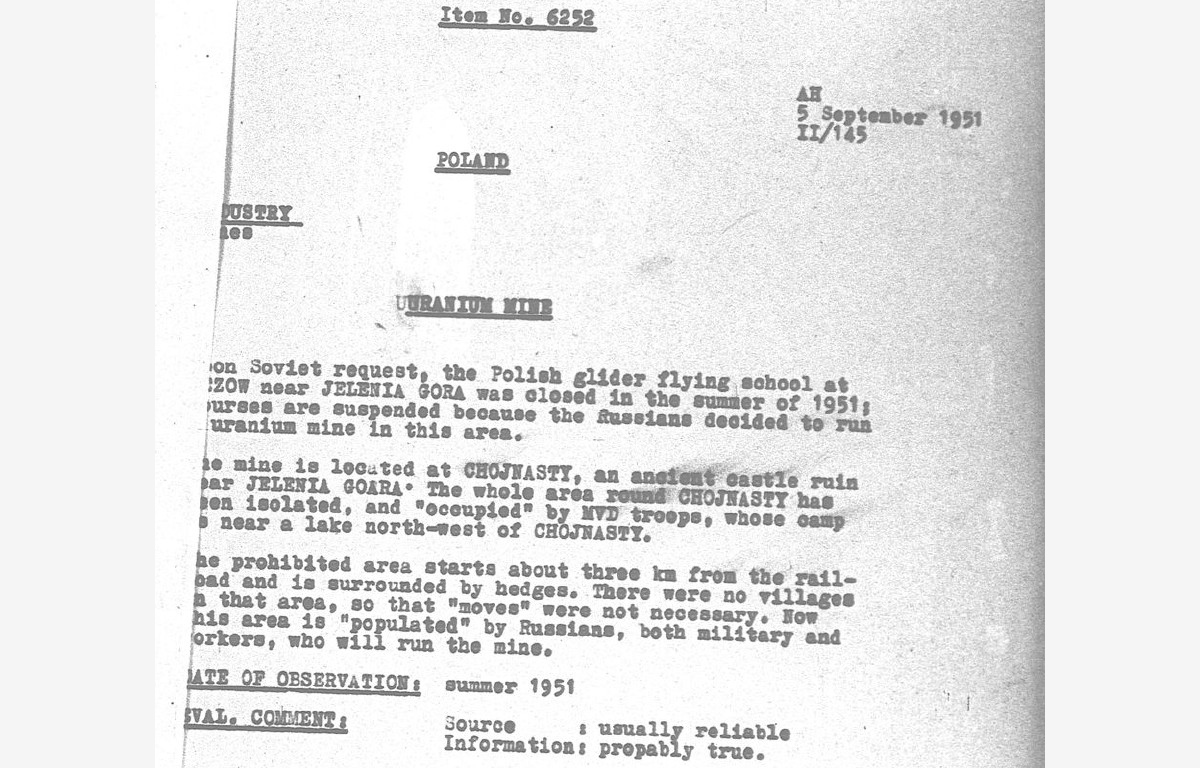 1957 Information Item on Soviet uranium mining in Poland.
1957 Information Item on Soviet uranium mining in Poland.
(From the Reference Information Paper on Nuclear Energy and Its Applications)
An impressive number of documents demonstrate a transnational take on the use of nuclear energy in the 1960s. In a decade that had, as far as nuclear proliferation is concerned, the 1962 Cuban Missile Crisis as its peak, nuclear research was in the center of international attention. The archival collection reflects a Western perception of the Soviet Bloc’s nuclear energy policies, noting, “whatever their official line, the Communist governments of Eastern Europe are facing the same problems as the West.”
Not only did RFE/RL specialists in Munich collect information, they also analyzed it. Several dozens of Situation Reports address nuclear tests, cooperation agreements, the safety of power stations and plants, the development in nuclear technology, international agreements on nuclear freeze, and many other issues across several countries. As for the documents covering the USSR, they emphasize the extent to which nuclear technology—and especially the concept of “peaceful atom”—was a matter of international politics: sometimes in terms of cooperation, but mostly in terms of competition. The long-lasting war in Vietnam, for example, also left a trace in this noncooperation, when Soviet scientists refused to accept awards as a gesture of protest. At the same time, reports capture societal activism against nuclear testing, which had begun in the Soviet Union and in the countries of the Eastern bloc, as well as in the West.
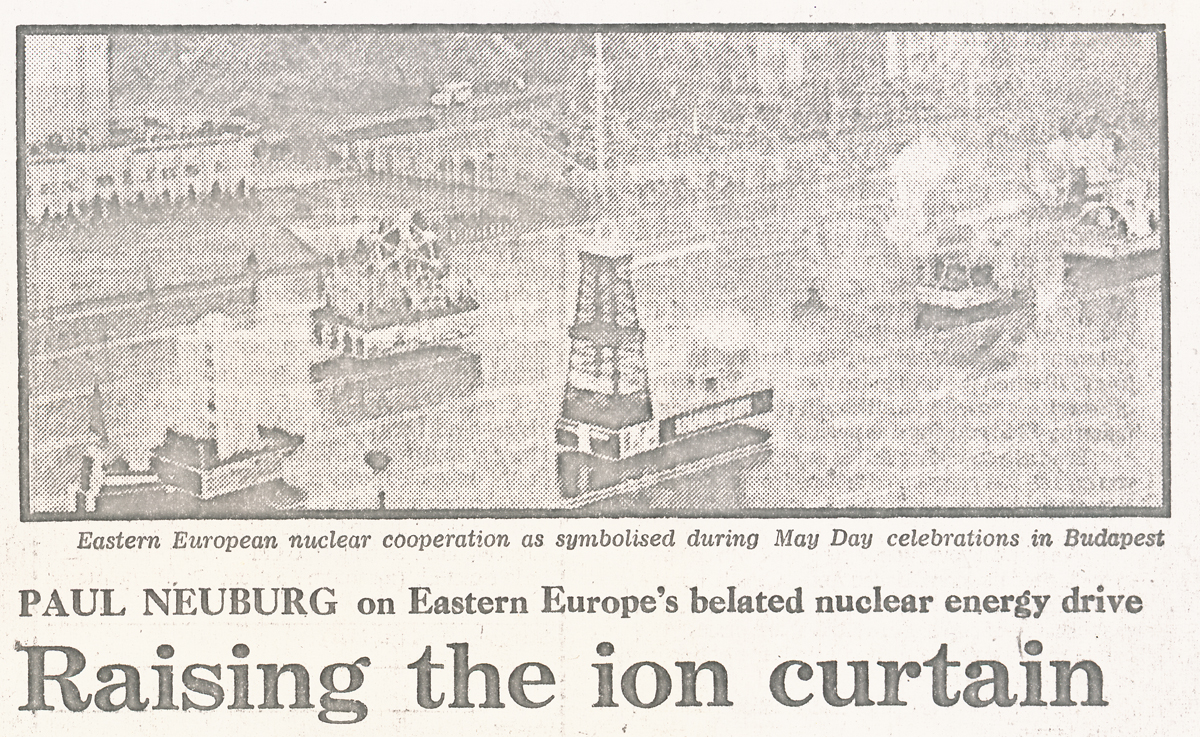 1974 press clipping from The Guardian.
1974 press clipping from The Guardian.
(HU OSA 300-120-3 Records of RFE/RL Research Institute, Western Press Archives, Subject Files)
The following decade, the 1970s, brought debates on radiation and its potential consequences, such as leukemia. In Bulgaria, public discourse continued to frame the nuclear power industry as the utmost outcome of scientific technical progress under Soviet “cooperation.” In Czechoslovakia, the idea of “peaceful atom” was recurrently presented as a feasible solution to the concern of electrification. In the GDR, the differences in power plant maintenance and safety standards in comparison to West Germany received special attention. In Hungary, nuclear energy policy in relation to the environment was thought to be of high importance. In Poland, new nuclear power plants were built and a new atomic energy policy and research developed in cooperation with experts from both the East and the West. Concerns of nuclear waste and atomic security were a priority. Documents on Romania focus on the foreign politics of the Ceausescu regime, revealing Ceausescu’s interest in nuclear energy. Files on Yugoslavia highlight the military aspect of nuclear research, which had to be abandoned in the mid-1970s due to lack of funding.
The accident at the Chernobyl nuclear power plant on April 26, 1986, is at the center of the collection from the 1980s. The Subject Files compiled at the Samizdat Archives, a separate unit at the RFE/RL RI, examine multiple consequences of the catastrophe, including political, societal, and environmental aspects. In 1986, new cemeteries were raised for Chernobyl victims all over the region. International experts described Chernobyl victims exposed to high doses of radiation as “living dead,” while villages neighboring the site were evacuated. The accident had a strong impact on the long-term development of Soviet nuclear energy. It also heightened the importance of international organizations, such as the International Atomic Energy Agency, which implemented new policies in the aftermath of Chernobyl; yet, the station itself continued working. Journalists called the manifold fallout “the long shadow” of Chernobyl, ranging from leukemia outbreak in the region to victims going on hunger strikes for social benefits. Despite horizontal self-organization and the establishment of an All-Union Chernobyl Society, thousands were still living a “nuclear nightmare” years after the accident.
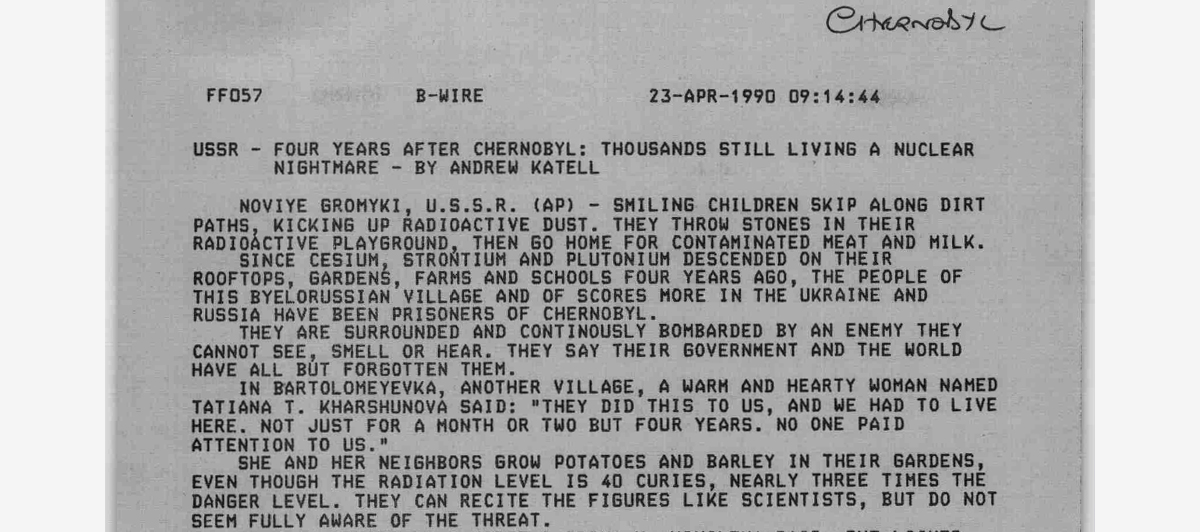 (Reference Information Paper on Nuclear Energy and Its Applications)
(Reference Information Paper on Nuclear Energy and Its Applications)
The Blinken OSA Archivum holds a special series of 44 hours of video interviews that explore this “nuclear nightmare” in great detail. In the 1990s, journalists Svetlana Alexievich and Tatiana Loginova interviewed scientists, engineers, party officials, priests, mothers of children with leukemia, medical radiologists, immigrants, and others from “The Zone.” The conversations, based on which Alexievich later published her acclaimed books Voices from Chernobyl and Chernobyl Prayer, reveal the nature of decontamination work, ignorance of local communities about radiation, daily life after the explosion, and most importantly the overall silence and almost total absence of information provided by the authorities right after the accident.
The Chernobyl accident triggered the rise of international attention to safety measures in nuclear reactors. At the same time, it didn’t stop developments in the military application of nuclear research. The RFE/RL Background Reports summarize the “nuclear debates” in the GDR or the dispute among NATO countries on the necessity to negotiate nuclear proliferation with Eastern Bloc countries, as well as the implementation of a post-Chernobyl nuclear program in the USSR and its neighbors despite the accident.
The documents also capture the public debate over the Soviet leadership’s responsibility for the accident and especially for its silence toward their own citizens and the international community. Back in 1986, fellow communists in Europe demanded adequate information and updates about the accident, while the state media in Hungary and other Eastern Bloc countries in general were “excessively slow in reporting” and “played down the potential danger to human health.” The Soviet leader at the time, Mikhail Gorbachev, became closely associated with the fallout and was heavily criticized for failing to show remorse and to act responsibly. Hopes were expressed that the accident would trigger an opportunity for the public in Eastern Europe to exercise a more direct influence over decision-making in terms of energy policy. These hopes, however, remained mostly unfulfilled. One year after the accident, experts noticed that the disaster affected only the pace of nuclear development in the region, and not a single country in Eastern Europe decided to halt its nuclear power program.
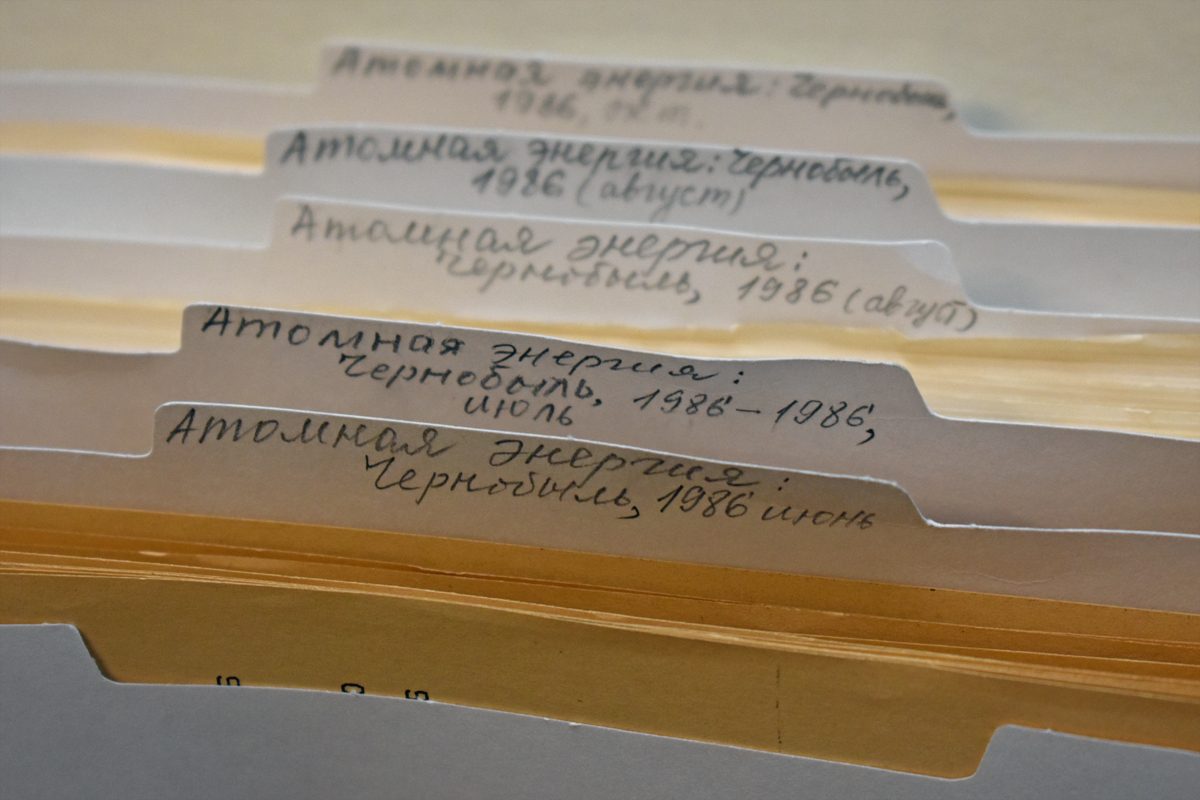 Files on Atomic energy: Chernobyl at the Blinken OSA Archivum.
Files on Atomic energy: Chernobyl at the Blinken OSA Archivum.
(HU OSA 300-80-1 Records of RFE/RL Research Institute, Soviet Red Archives, Old Code Subject Files)
Nuclear weapons were a field that caused another true concern internationally. Fortunately, the long and protracted negotiations gravitated toward nuclear disarmament. After decades of arms race, negotiations on limiting nuclear weapons in Europe started in the 1980s. Despite being reluctant to provide information about the Chernobyl accident, Gorbachev, with time, did take personal responsibility for the catastrophe, and invested significant effort in nuclear disarmament. The history of nuclear non-proliferation and Gorbachev’s role in will be the topic of a next blog post.

